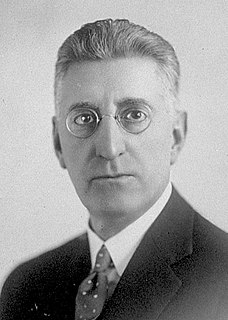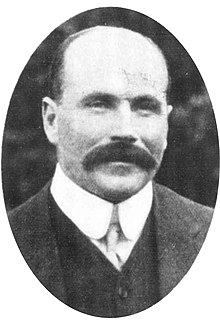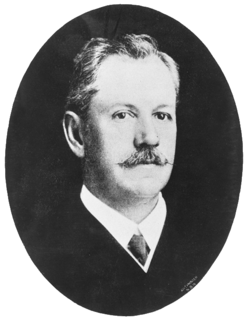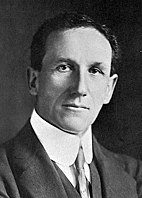
William Arthur Holman was an Australian politician who served as Premier of New South Wales from 1913 to 1920. He came to office as the leader of the Labor Party, but was expelled from the party in the split of 1916. He subsequently became the inaugural leader of the NSW branch of the Nationalist Party.

Reginald Walter Darcy Weaver was an Australian conservative parliamentarian who served in the New South Wales Legislative Assembly for 28 years. Serving from 1917 in the backbenches, he entered the cabinet of Thomas Bavin in 1929 as Secretary for Mines and Minister for Forests until he returned to opposition in 1930. Following the success of the United Australia Party in the 1932 election, Weaver returned as the Secretary for Public Works and Minister for Health in the Stevens ministry.
Members of the New South Wales Legislative Assembly who served in the 48th parliament held their seats from 1984 to 1988. They were elected at the 1984 state election, and at by-elections. The Speaker was Laurie Kelly.</ref>
Albert Bruntnell was an Australian politician. He was a member of the New South Wales Legislative Assembly from 1906 until his death and held a number of ministerial positions in the Government of New South Wales. He was a conservative and at various times he represented the Liberal and Reform and the Nationalist parties.
George Roy William McDonald was an Australian politician.
Members of the New South Wales Legislative Assembly who served in the 27th parliament of New South Wales held their seats from 1925 to 1927. They were elected at the 1925 state election on 30 May 1925. The Speaker was James Dooley.</ref>
Members of the New South Wales Legislative Assembly who served in the 25th parliament of New South Wales held their seats from 1920 to 1922. They were elected at the 1920 state election on 20 March 1920. The Speaker was Daniel Levy with the exception of 13–20 December 1921 when he was replaced by Simon Hickey.
Members of the New South Wales Legislative Assembly who served in the 23rd parliament of New South Wales held their seats from 1913 to 1917. They were elected at the 1913 state election on 6 December 1913.</ref> The Speaker was Richard Meagher.
Members of the New South Wales Legislative Assembly who served in the 24th parliament of New South Wales held their seats from 1917 to 1920. They were elected at the 1917 state election on 24 March 1917.</ref> Speaker was John Cohen until 19 August 1919 when he was succeeded by Daniel Levy.

William George Ashford was an Australian politician.

Henry "Harry" Clement Hoyle was an Australian politician and rugby league football administrator of the 1890s and 1900s. A life member of the New South Wales Rugby League, Hoyle is credited with helping to craft the rhetoric justifying its successful split from the New South Wales Rugby Football Union.

The Holman ministry , also known as the Second Holman ministry or Holman Nationalist ministry was the 36th ministry of the New South Wales Government, and was led by the 19th Premier, William Holman.

The Storey ministry was the 37th ministry of the New South Wales Government, and was led by the 20th Premier, John Storey.

Richard Thomas Ball was a politician and engineer in New South Wales, Australia.
Patrick Joseph Minahan, was an Irish-born Australian politician.

The 1922 New South Wales state election was held on 25 March 1922. This election was for all of the 90 seats in the 26th New South Wales Legislative Assembly and it was conducted in multiple member constituencies using the Hare Clark single transferable vote. The 25th parliament of New South Wales was dissolved on 17 February 1922 by the Governor, Sir Walter Edward Davidson, on the advice of the Premier James Dooley.

The 1920 New South Wales state election was held on 20 March 1920. The 24th parliament of New South Wales was dissolved on 18 February 1920 by the Governor, Sir Walter Edward Davidson, on the advice of the Premier William Holman. The election was for all of the 90 seats in the 25th New South Wales Legislative Assembly, and it was the first to be conducted with multi-member electorates, using the Hare-Clark single transferable vote system.
This is a list of candidates for the 1917 New South Wales state election. The election was held on 24 March 1917.

The 1907 New South Wales state election was held on 10 September 1907 for all of the 90 seats in the 21st New South Wales Legislative Assembly and it was conducted in single-member constituencies with a first past the post voting system. Both adult males and females were entitled to vote, but not Indigenous people. The 20th parliament of New South Wales was dissolved on 19 August 1907 by the Governor, Sir Harry Rawson, on the advice of the Premier, Sir Joseph Carruthers.
Belmore, an electoral district of the Legislative Assembly in the Australian state of New South Wales was created in 1904 and abolished in 1920.











